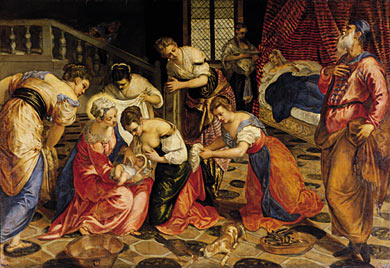 |
 |
 |
   |
 |
 |
 |
|
By the middle of the sixteenth century, the Venetian state was once more experiencing a boom period: thanks to skillful diplomacy, the Republic had been able to solidify its position on the European arena. The favorable political situation led to a wave of renewal which encompassed all spheres of public life—including the arts. During this period, the value and uniqueness of the Venetian school of painting was recognized through the means of polemical exchanges between Florentine and Venetian theoreticians, crowned by the publication of Giorgio Vasari's Lives of the Artists in 1556 and the Venetians' response, Lodovico Dolce's L'Aretino o dialogo della pittura of 1557, with its defence of Venetian painterly qualities.
We should bear in mind that these years of discussion coincided with an intensive search for new artistic devices, for a new painterly means of expression, which resulted at last in the emergence of artists whose manner differed radically from that of the recognized head of the school, Titian. As early as the 1540s, Pietro Aretino explained the new dominant principle of expression—movement—and soon found confirmation of his ideas in the painting The Miracle of St. Mark, by the then-young Jacopo Robusti, known as Tintoretto. By the middle of the century, Tintoretto's talent had been revealed in all its originality—even while it had absorbed many of the achievements considered the traditional territory of Venetian artists. A magnificent color scheme, a festive scene enlivened by genre details, which gave the event a sense of realistic conviction—such were the defining features of Venetian historical narrative painting even in the fifteenth century. All of these qualities were brilliantly manifested in this Hermitage painting of a New Testament subject, The Birth of John the Baptist.
The scene unfolds within a rich Venetian house, with all its characteristic features: the colored marble patterned floor, the striped silk baldachin over the luxurious carved bed in the depths of which lies Elizabeth, John's aged and tired mother. In the foreground are numerous serving women fussing over the newborn child, readying his swaddling and a cradle; the wet-nurse kneels down to the child lying on the knees of the Virgin Mary. Despite the narrative tone, nothing detracts from the multiple symbols of the episode—many of the objects depicted contain a hidden subtext: the empty font is a symbol of the purity of John's birth and his future role as the Baptist; the young cockerel announces the coming of the sun, just as John will declare the coming of Christ; the creeping cat is the embodiment of night or death; and to its right in a copper bowl are the burnt bones of animals, with which, according to legend, water was purified; this last element also hints at the future, at John's second "martyrdom" after death when his bones were burnt and the ashes scattered.
The rich, bright clothing of the serving maids blends into the resonant harmony of color with its two dominant accents—Mary's bright red dress and Zachariah's deep wine-red robes. Clearly this resolution was influenced by the art of a young painter who had only just made his name in Venice, Paolo Veronese, providing a new stimulus to Tintoretto's already powerful gift for color. His expressive range of color is combined with a dynamic, striking spatial resolution, lacking in any Renaissance symmetry or equilibrium. Phosphorescent flashes of light, rhythmic gestures, elongated figures in unstable poses—all introduce a note of disturbance into the composition, emphasizing the mystic significance of the event taking place before our eyes.
When in the collection of Cardinal Mazarin, Tintoretto's painting was recorded under the title The Nativity of the Virgin. Later, in the Crozat collection and after it was acquired by the Hermitage, the canvas was listed as The Birth of John the Baptist, which is indeed the title inscribed beneath the engraving by Frederic Horthemels in the Recueil Crozat (1729). The painting continued to be thus identified until 1889, when it was once more entered in Hermitage catalogues as The Birth of the Virgin, by analogy with a similar composition on that subject in the Church of San Zaccaria in Venice. Just twenty years later, however, in 1912, the true title The Birth of John the Baptist was reestablished, and the subject has never since been disputed within the Hermitage. Liphart quite justly noted that we can clearly identify the Virgin Mary in the central female figure holding the newborn child, for a halo surrounds her head and she wears the traditional colors of the Madonna, a red dress and blue cloak. To the right stands Zachariah, whose speech has returned, and who names the child Ioann or John (Gospel According to St. Luke, 1:57–80).
Despite the obvious reading of the scene, outside the Hermitage the incorrect title remained in force for many years. The reason behind this misunderstanding is that some authors saw the Hermitage work, without foundation, as a repetition of the Nativity of the Virgin in San Zaccaria. The disagreement about the subject unfolded in an extremely lively and unjustly drawn-out discussion. Paola Rossi, citing essentially the same arguments as Liphart, once again confirmed the correctness of the title accepted in the Hermitage. A far more interesting question, although it has not so far found even any hypothetical resolution, is what was the original purpose of the painting: canvases of similar dimensions and format were usually intended for the interiors of religious buildings, for churches or the brotherhoods known as scuole. It is strange that a work so notable in all senses should not have been noticed and described by Venetian chroniclers.
The most likely date for The Birth of John the Baptist is 1554/1555, the time when Tintoretto's interest in lighting effects was still balanced by a desire for bright, polychrome compositions. Just such a balance is revealed in this Hermitage canvas.
—Irina Artemjeva
|
|
|



